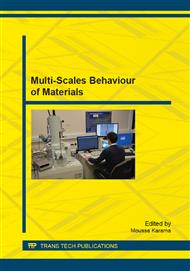[1]
K. Ait tahar , A. Chateauneuf , : confinement of the Concrete Structures by Embedded Composite Grids » journal Key Engineering Materials Vol. 425, 2010 pp.195-216.
DOI: 10.4028/www.scientific.net/kem.425.195
Google Scholar
[2]
T. Kamada , V LI. : The effect of surface preparation on the fracture behaviour of ECC/concrete repair system. Cement & Concrete composite, 2000, vol. 22, pp.423-431.
DOI: 10.1016/s0958-9465(00)00042-1
Google Scholar
[3]
M.J. Houde, : Modélisation de poutres en béton armé endommagées par chargements cycliques. Comportement en flexion et en cisaillement ; Mémoire présenté à la Faculté des études supérieures de l'Université Laval dans le cadre du programme de maitrise en génie civil pour l'obtention du grade de maîtrées sciences (M. Sc). Département de génie civil, faculté des sciences et de génie, université laval. QUEBEC, mars (2007).
DOI: 10.3166/regc.9.523-546
Google Scholar
[4]
M. Lorain, O. Maurel, S. Boukari et M. Pinto-Barbosa. : Comportement en Flexion de Poutres en Béton de Hautes Performances munies d'armatures de Hautes Performances – Etude expérimentales et Numérique , Matériels and Structures/ Matériaux et Constructions, Vol. 32, December 1999, pp.708-718.
DOI: 10.1007/bf02905067
Google Scholar
[5]
JP. Mougin. : Calcul des éléments simples et des structures de bâtiments , Berti-Editions. Alger (1994).
Google Scholar
[6]
H.P. J Taylor, : The fundamental behavior of reinforced concrete beams in bending and shear, IN Proc. ACI-ASCE Shear symposium, Ottawa, ACI Detroit, SP 42-O3, Vol 42, 43-78, (1974).
Google Scholar
[7]
B. Mahut, : Diagnostic des ouvrages en béton armé : état, méthodes, prévision du vieillissement , In : Diagnostic des Ouvrages en Béton Armé Etat – Méthodes - Prévisions du Vieillissement, Journées d'étude de la Commission Construction Bâtiment du Centre Français de l'anticorrosion, octobre 1998, France, pp.67-76.
DOI: 10.51257/a-v1-c6300
Google Scholar
[8]
P. A. Ovigne, : Comportement modal de poutres en béton armé fissurées avec renfort en matériau composite,. Thèse de doctorat, Université Claude Bernard Lyon 1, (2001).
Google Scholar
[9]
K. Yoshimura, K. Kikuchi, M. Kuroki , H. Nanoka , T. Croston , S. Koga , K.T. Kim , L. Ma,: Experimental study for higher seismic performance of masonry walls in developing countries,. Proc. of 25th Conference on Our World in Concrete & Structure, 2000, pp.695-702.
Google Scholar
[10]
K. Yoshimura, K. Kikuchi, M. Kuroki , H. Nanoka , T. Croston , S. Koga , K.T. Kim , L. Ma, L. Itai , : Matsumoto Y. Experimental study on effects of reinforcing details on seismic performance of masonry walls,. Proc. Of 26th Conference on Our World in Concrete & Structure, 2001, (CD-ROM).
Google Scholar
[11]
H.N. Garden, L.C. Hollaway,: An experimental study of the failure modes of reinforced concrete beams strengthened with prestressed carbon composite plates,. Composites Part B, 1998, vol. 29B, pp.411-424.
DOI: 10.1016/s1359-8368(97)00043-7
Google Scholar


